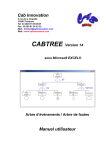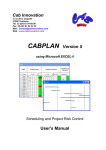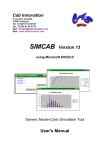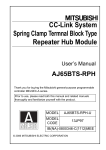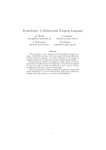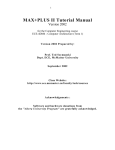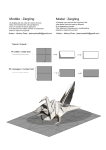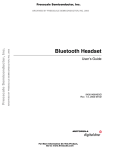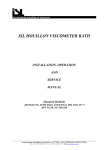Download 1 GENCAB Software
Transcript
Cab Innovation 3 rue de la Coquille 31500 Toulouse Tel. 33 (0)5 61 54 68 08 Fax. 33 (0)5 61 54 33 32 Mail : [email protected] Web : www.cabinnovation.com GENCAB Version 13 using Microsoft EXCEL® Optimizing With Genetic Algorithms & Simplex User's Manual FOREWORD The software GENCAB BASIC version 4 includes some of the GENCAB version 13 features. It is not the subject of a specific user manual. The copyright law and international conventions protect the GENCAB software and its User’s Manual. Their reproduction or distribution, either wholly or partly, through any means whatsoever, is strictly prohibited. Any person who does not comply with such provisions is committing an offence of forgery and is liable to prosecution and can be sentenced under the provisions prescribed by the law. The Programming Protection Agency (A.P.P.) references GENCAB at the I.D.D.N. (Inter Deposit Digital Number) index, with the following reference: IDDN.FR.001.070019.00.R.P.2000.000.20600 2 CONTENTS : 1 GENCAB Software 1.1 General Presentation 1.2 Installing GENCAB on hard disk 1.3 Starting GENCAB 2 Teachware 2.1 2.2 2.3 2.4 2.5 2.6 Principle of optimization Types of problems and methods of resolution Simplex and Genetic Algorithms Coupling with method of evaluation or simulation Taking into account of the constraints Adjustment of probabilistic models 3 Application 3.1 3.2 3.3 3.4 3.5 Parameters initializing Entering the constraints Assessment Processing Adjustment of probabilistic models 4 Algorithms 4.1 General Presentation 4.1.1 Genetic Algorithms 4.1.2 Differential Evolution 4.1.3 Nonlinear Simplex 4.1.4 Coupling between optimization and Monte-Carlo simulation 4.2 Algorithms' Selection and Setting 4.2.1 Mutation 4.2.2 Crossbreeding 4.2.3 Selection 4.2.4 Setting to Scale 4.2.5 Taking into account of the constraints 4.2.6 Optimization starting from results of simulation 4.3 Initial Population 5 Examples of Applications 5.1 5.2 5.3 4.4 5.5 Mathematical Functions Polynomial Adjustment Combinatory Problem Linking with SIMCAB Software Linking with SUPERCAB Software OPERATING LICENCE AGREEMENT 3 1 GENCAB Software 1.1 General Presentation GENCAB is a generic optimizing software implementing developments which are among the latest in operational research and artificial intelligence. Based on a hybrid optimizing method with Genetic Algorithms and non-linear Simplex, it enables to optimize (real, integer or binary) parameters of any function, with possible constraints, without stopping at the first local optimum found. Its general principle is described in diagram below: GENCAB Set of parameters (binary, integer, real) Function defined by user on a spreadsheet folio Genetic algorithms Differential Evolution & Simplex Assessment result Selections and settings The user defines the function to be optimized on a spreadsheet folio from different parameters. The function may be directly entered in spreadsheet cells, may use macrofunctions or be implemented using a link between sheet and existing softwares. Constraints between parameters or cells of the sheet can be also defined. Then, the software automatically searches the optimal parameter configuration which maximizes or minimizes the function result; this result being likely to be located in any sheet cell. GENCAB requires no especial knowledge in mathematics and may be used in any engineering field. It is delivered in a setting configuration of its algorithms which enables to efficiently process highly different functions. However, the user may modify at his discretion the different setting parameters to consider more efficiently specificities of functions to be processed. The understanding of algorithms being used is therefore required, and such algorithms are described in Chapter 3. 4 GENCAB allows to adjust probabilistic models by using maximum likelihood method, using uncensored or censored data (right, left or interval). It considers acceleration factors (Arrhenius, Basquin, Cox, etc..) to process heterogeneous data from different environments and conditions of use. 1.2 Installing GENCAB on Hard Disk Please follow instructions shown in manual. 1.3 Starting GENCAB In EXCEL, open GENCAB.XLA file. Software's functionalities are then accessible using menu "Optimisation", spreadsheet functionalities remaining always available. Banner on Excel versions after 2007 Menu on Excel versions prior to 2007 A help and a teachware are proposed in the menu. 5 2 Teachware The teachware presents optimization by means of various boards and many demonstrations. 2.1 Principle of optimization 6 2.2 Types of problems and methods of resolution 7 2.3 Simplex and Genetic Algorithms 8 9 10 2.4 Coupling with method of evaluation or simulation 11 12 2.5 Taking into account of the constraints 2.6 Adjustment of probabilistic models 13 14 15 3 Application After the entry of a function by the user on the spreadsheet and the definition of the type and range of parameters to optimize, the tool allows:: . assess function according to one or two variables (curves 2D or 3D) . search the optimum. These features described below are illustrated by the following example entered in a spreadsheet cell : f(x,y,z) = sin(x + y) * sin(x - z) / (1 + (x2 + y2 + z2)1/2 with x, y, z real, comprised between 10 and +10. "=SIN(Var1+Var2)*SIN(Var1-Var3)/(1+(Var1^2+Var2^2+Var3^2)^0,5)" The expression "#NAME?" is obtained if parameters have not been initialized. 3.1 Parameters initializing The command "Parameters" of menu "Optimisation" allows to display the following dialog box in which the user enters the characteristics of function parameters to optimize. The scrolling menu at the top right allows to enter the parameters number (≤150). 16 The list of parameters appears in a second scrolling menu. For any of them, the user specifies the type (real, integer or binary) with maximum and minimum limits of variation range. Except for the binary case, such limits should be imperatively informed. The variable name "Va_i" is default, but can be modified directly in the box. Equivalence is then defined between the new and old names (x ≈ Va_1 for example). The button allows to select the names of previously defined parameters on the selected sheet using the following dialog box. . The button allows to get a entry table, as indicated below. The taking into account of the information entered in the table by the user is carried out by an action on the button located on the corresponding sheet. The button allows to validate the characteristics of the selected parameter. The dialog box then displays the characteristics of the parameter following in the list, if they were beforehand defined, or preserves those of the precedent in order to facilitate the initialisation 17 of parameters having the same characteristics. A parameter can be also selected directly in the list by using the scroll box. On completion of this initialization phase, the names of parameters "Va_1", "Va_2" … "Va_n", and their possible equivalence, are automatically defined in spreadsheet and their value is drawn randomly in the corresponding range. Names of limits "max_vari" and "min_vari" are also defined in sheet. 3.2 Entering the constraints Command "Constraints" of menu "Optimisation" allows to display the following dialog box used to enter constraints between parameters or cells of the sheet. The constraints considered are of type: A >= B, A = B, A <= B or A Integer, in which A and B are cells references or combinations of parameters. Three scrolling menus facilitate the definition of the constraints. The name of parameters beforehand defined in the worksheet can be immediately entered and, in position "REF", simple a clic of the mouse allows to enter the reference of the selected cell. Button and make it possible to record the constraint in progress or to delete a beforehand definite constraint, selected in the corresponding list. 18 3.3 Assessment Command "Assessment" of menu "Optimisation" initiates the display of the following dialog box helping assess the function typed on spreadsheet folio for a given configuration of parameters, or draw variation graphs according to one or two parameters. The box "Cell" allows to enter the address of the cell of the sheet which includes the result of the function to evaluate (automatic entering by the use of the mouse). Any parameter can be selected in the same way as in the dialog box "Type of parameter" so as to give it an especial value (comprised between its limits). This value will be immediately considered in spreadsheet folio following validation. Options Abscissa 1 and Abscissa 2 allow opting for one or two parameters to be considered as variables in a graph with two or three dimensions that will be automatically generated by the software following validation. The user may then define a number of values equidistant from the selected parameter (11 by default) located in a subassembly of the variation range (entire range by default) to be subject to an assessment. The function being previously taken as an example, thereby reaches the graphs thereafter at one dimension according to x or two dimensions according to x and y. 19 0,03 0,02 0,01 9 10 8 7 6 5 4 3 2 1 0 -1 -2 -3 -4 -5 -6 -7 -8 -9 -1 0 0 -0,01 -0,02 -0,03 -0,04 -0,05 -0,06 -0,07 -0,08 Var1 Graph of function f(x,y,z) = sin(x + y) * sin(x - z) / (1 + (x2 + y2 + z2)1/2 according to x 0,5 0,4 0,3 0,4-0,5 0,2 0,3-0,4 0,2-0,3 0,1 0,1-0,2 0-0,1 -0,1-0 0 -0,2--0,1 -0,3--0,2 -0,1 10 6 -0,2 2 -2 -10 9,5 8 6,5 5 2 0,5 3,5 Var2 Var1 -6 -1 -4 -2,5 -5,5 -7 -8,5 -10 -0,3 Graph of function f(x,y,z) = sin(x + y) * sin(x - z) / (1 + (x2 + y2 + z2)1/2 according to x and y The same function with the constraint y ≥ 2 - x 20 3.4 Processing Command "Processing" of menu "Optimisation" generates the display of the following dialog box which helps performing the optimizing of function to be processed. User specifies whether the search regards the minimum or the maximum and defines a number of processing loops as a criterion to stop the search. It may also use two other criteria to stop: . reaching a better result than an a-priori defined value, . outstripping a certain processing duration (in hours). The box "Cell" makes it possible to enter the address of the cell of the sheet which includes the result of the function to optimize (automatic entering by the use of the mouse). The option "Initialize the treatment again" allows not memorizing the best result possibly obtained previously. The option "Display successive results" helps displaying the best result obtained all over the processing. The option "Display final population" allows to display the features of population obtained at end of processing (see general presentation of Genetic Algorithms in Chapter 3.1). This population can be changed by the user and serve as an entrance to a new processing by using the button on the sheet. The option "Adjustment of origin" helps finding out the proposed processing-algorithm setting configuration when starting up the software. 21 This configuration may be totally modified by the user using command "Algorithm" of menu or partly modified using two 5-position cursors of this dialog box. The first one allows working on the algorithm's exploration level and the second one on the operation level (multiplication or division by 2 or 4 of size of chromosome population or the number of simplex steps with respect to current state). Without using the command "Algorithm" of the menu, a cursor with 8 positions of this same dialog box makes it possible to modify the factor of penalty affecting the results in the event of going beyond of possible constraints. The button "Adjustment" makes it possible to reach directly the command "Algorithm" without passing by the menu. Al over the processing, the software specifies in the status bar (in screen's lower section) the number of processing loop in progress, the duration of a loop, the number of function assessments performed during each loop and the duration of an assessment (higher than 1 second). As the optimum is not necessarily reached at end of processing, the user may repeat the latter while maintaining the best result obtained so far. The maximum of function f(x,y,z) = sin(x + y) * sin(x - z) / (1 + (x2 + y2 + z2)1/2, assumed as an example, is thereby obtained following a few processing loops : Var1 Var2 Var3 Result -0,920822364 -0,460411148 0,460411163 0,453288276 Remark: The stochastically optimizing methods, such Genetic Algorithms, allow searching the global optimum of a function without guaranty to find it. 3.5 Adjustment of probabilistic models The "Adjustment" command of the "optimization" menu involves the display of the next dialog box that lets you adjust probabilistic models by using maximum likelihood method. The action on the button “?” direct access to the relevant pages of the tutorial. 22 Using scrolling menus, the user chooses a probability distribution, associated with a possible acceleration law. It also indicates whether the data are censored. The action on the OK button causes the display of a new dialog box in which the user indicates, using the mouse, the address of data previously entered in a spreadsheet, as in this example above. 23 If an acceleration law other than the Cox model was selected, the address of the reference values of the covariates must also be entered in the dialog box. The data will first be converted to the reference conditions by using an acceleration factor. The action on the OK button causes the generation of a worksheet, as below, and then launches the processing. Processing can be restarted by the user as many times as necessary. The latter can also change the minimum and maximum limits proposed by the tool for each parameter. At the end of processing, a dialog box proposes to estimate confidence intervals on the parameters or quantile values, by inverting the Fischer matrix. It also proposes to show the results in the form of various graphs (distribution function and Kaplan Meier curve, quantile/ quantile diagram, Weibull paper, etc.). 24 4 Algorithms 3.1 General Presentation 4.1.1 Genetic Algorithms Developed by John Holland et al at the University of Michigan, genetic algorithms are optimizing algorithms based on natural selection and genetics mechanisms. The first of such mechanisms deals with principles of survival of best-adapted species based on Darwin postulate. The second one relies on diversity of individuals in a population of a same species that evolves over the time by crossbreeds and mutations. The analogy between biology and genetic algorithms is shown in Figure 4.1. Genetic algorithms Chromosomes Genes Allele Parameter configuration Parameters Parameter values 9 2,3 -5 1 0 -0,8 Figure 4.1 - Analogy between biology and genetic algorithms Each parameter configuration corresponds to a chromosome whose genes are parameters of different types (binary, integer, real). Such chromosomes are affected, within a population, mutation, crossbreeding, and selection … operations considering respective performance of each single one (Figure 4.2). Chromosome population (Permanent size) Mutation Crossbreeding Selection Figure 4.2 - Basic principle of genetic algorithms 25 For every generation, a new identical-size population is created, consisting partly of best elements of previous generation and new elements generated by mutation or crossbreeding. Such operations are conducted in accordance with two objectives: reaching local optima and exploring variable space to search all optima in order, in this way, to find out the global optimum. Mutation consists in introducing a noise in the gene value of a chromosome, i.e. a random deviation around such value. In this respect, mutation is an exploration operation of the searching space. Figure 4.3 shows an example of mutation to be applied to different types of parameters. Disturbance introduced in the parameter value Binary : 1101101101 Integer and real : 1101001101 ' xk xk xk' = xk + ( xk − xmin ) × Amplitude xmin or ' xk = xk + ( xmax − xk ) × Amplitude xmax xk Random amplitude, decreasing over the time. Figure 4.3 - Example of mutation In this example, mutation of a chromosome, randomly drawn in population, is carried out through modification of one of its randomly selected genes. Such gene simply changes state if binary or performs a decreasing amplitude leap over the time if real or integer, so as to progressively limit the exploration as research goes on. Crossbreeding is performed by pairing two population chromosomes which exchange information each other to give birth to two descendants. Just as for mutation, crossbreeding is an exploration operation of the research space of which two examples are given in Figure 4.4. Exchanging information between chromosomes Crossover 00011I011000111 01001I01100011 01001I010010101 00011I010010101 x’1 x1 x’1 =αx1+(1-α)x2 Barycentric x2 x’2 0 < α <1 x’2 =αx2+(1-α)x1 Figure 4.4 - Examples of crossbreeding 26 In these examples, crossbreeding of two parent chromosomes randomly drawn in population is carried out either by gene exchange (crossover), each gene being reproduced in either descendants, or by averaging values (integer or real) of parent genes (barycentric). Selection is a process whereby each chromosome is duplicated a number of times in the new population according to value (or fitness) of function to be optimized (also called adaptation function). Chromosomes, the adaptation function value of which is high, have a strong probability to contribute to the next generation, by creating one or more descendants identical to them. Such operator, an example of which is proposed in Figure 4.5, is of course an artificial version of the biological selection. In the nature, adapting a species is determined by its ability to survive to predators, diseases, and obstacles to get over to reach adulthood and reproduction period, whereas in our artificial environment, the function to be optimized is the final arbitrator of life or death of any chromosome. In this respect, selection operation is a development operation of research space. Duplicating best adapted chromosomes Example : Population n: Chromosomes : 1 2 3 4 5 6 7 8 9 10 Fitness (fi) : 0,98 1,30 0,82 0,50 0,65 1,06 0,13 0,65 0,04 0,10 Pi : 0,16 0,21 0,13 0,08 0,10 0,17 0,02 0,10 0,01 0,02 1% 2% 10% fi Draw by Lottery wheel pi = 10 ∑f i =1 Population n+1 : 1 16% 2 3 2% 4 5 17% 21% 6 7 8 i 10% 9 13% 8% 1 1 2 2 2 2 3 10 5 6 6 Figure 4.5 - Example of selection In this example, selection probability pi of each chromosome, computed from the relative weight of the result of its assessment, corresponds to a lottery wheel section whereby N draws are carried out to obtain the new population (N being the constant population size). In addition to the specified examples, mutation, crossbreeding and selection operations may be performed in different ways proving to be more or less efficient depending on problems to be dealt with. Moreover, the optimum research may be improved by linking with such basic operations more classical techniques of setting to scale, elitism, or optimizing (method of climber). Setting to scale is transformation acting on the adaptation function value whose purpose is creating a zoom effect on results as research goes on. At first steps of research, deviations between fitness are wished to be reduced so as to prevent good chromosomes from becoming too predominating. Then, deviations are amplified to accelerate convergence. Elitism consists in preserving, for each generation, a number of best population chromosomes which might disappear due to mutation, crossbreeding or selection operations. A climber method, such as non-linear simplex, may be related with the genetic algorithm to form together a hybrid method with a best ability to develop (research of local optima). 27 4.1.2 Differential Evolution Proposed in 1995 per K Price and R. Storn, the Differential Evolution consists in generating a new chromosome by adding to genes of a member of the population the difference between genes of two other chromosomes. Similar to the mutation and the crossbreeding of the Genetic Algorithms, this operator explores the space of the solutions by simultaneously modifying the totality of genes of each chromosome. It requires a permanent diversity of each gene in the population to avoid a premature convergence. Also, a hybrid use associating Genetic Algorithms, Differential Evolution and nonlinear Simplex, is particularly robust to solve various problems. 4.1.3 Nonlinear simplex The local method of the nonlinear simplex, illustrated below, can be associated the genetic algorithms and the differential evolution to constitute together a hybrid method having a better capacity of exploitation (research of the local optima). Fitness ? Y Contraction B Expension Reflexion X Simplex of n+1 points in Rn 28 4.1.4 Coupling between optimization and Monte-Carlo simulation The function to be optimized cannot be always expressed in an analytical way and its evaluation can result from a Monte-Carlo simulation (see an example of coupling with the simulation software SIMCAB in chapter 4.4). However, the coupling between optimization and stochastic simulation, which consists in search of an optimal configuration of parameters starting from the results of a function of evaluation treated by Monte-Carlo simulation, is very penalizing in term of duration of treatment. At first approximation, the number of simulations to be realized is equal to the number of evaluations necessary to optimization multiplied by number N of simulations required by the required precision. This is why GENCAB implements an original strategy consisting in varying, during the treatment, the number of simulations Ni of each evaluation, by exploiting the average and the variance of the results obtained starting from a preliminary evaluation limited to N0 simulations. N0 Ni Ni/Nj = [(M-mj0)*σj0/ (M-mj0)*σj0]2 Nj M (current optimum) mi 0 σi0 mj0 σj0 mi σi mj σj The guiding principle of this technique consists in giving to each solution the same probability of inappropriate rejection, which results in a condition between respective values Ni and Nj of the number of simulations realized to evaluate two candidates I and J. This condition results directly from the application of the central limit theorem. In order to significantly decrease the total duration of the treatments (from 1 to 30 according to the problems to be solved and the adjustment of the algorithms), the user can thus activate this strategy by defining the N0 number of simulations carried out for the coarse evaluation as well as number N necessary to the necessary precision. He can also make grow the precision requested during the treatment, parallel to the progressive improvement of the population of solutions. Note: Contrary to the ordinary coupling between simulation and optimization, optimization should not relate to results of simulation in the form of a combination between average value and/or standard deviation, when this technique of improvement of the coupling is activated. 29 4.2 Algorithms' Selection and Setting Command "Algorithm" of menu "Optimisation" generates the display of following dialog box which helps set the optimizing parameters. The user may define the population size and choose among different mutation, crossbreeding and selection operators. He may also select a setting to scale, by choosing between two different techniques (Truncation or Exponential), an elitism operator, by specifying the number of individuals to be maintained for each generation, and a link with Simplex algorithm, possibly limited to certain loops of calculation (in proportion and starting from a certain row).. If Simplex is selected, the user should define a number of chromosomes, among the best of the population, from which a local optimum will be searched. He should also indicate a number of processing steps to be carried out for this research and possibly select the option "Without Replacement". 30 When such option is requested, the chromosome is no longer replaced by the local optimum being found by simplex but its fitness assumes the value of that of the optimum, which may increase chances to find out new optima on subsequent mutations. Simplex with replacement Depending on options selected, validation generates the display of different additional dialog boxes. 4.2.1 Mutation Three operators of change are proposed to the user: • That described on figure 4.3 of the chapter 4.1.1 (Type 1) • Differential Evolution (Standard 2) • A mixed use of these two operators (Type 3) According to the type of operator chosen, the following dialog boxes allow to define the mutation probability of each chromosome, the decrease in mutation amplitude of a real or integer gene and the mutation probability of a binary gene. The mutation amplitude of a real or integer gene can be governed by an adaptive control or the following expression: 1 − r (1 − 31 t b ) T where r is a random number comprised between 0 and 1 and t the number of the processing loop. 1 1 0<b<1 b>1 0 T 0 T 4.2.2 Crossbreeding One of the two crossbreeding operators described in Figure 4.4 (Crossover or barycentric) may be selected by the user. The above described dialog box helps define the crossbreeding probability of each population chromosome with another one randomly chosen in such population. 4.2.3 Selection In addition to the selection with lottery wheel shown in Figure 4.5, the software proposes three other selection operators: . Sampling of remaining part without replacement . Sampling of remaining part with replacement . Deterministic sampling Such operators, which cannot be parameterized, perform the selection as follows: 32 Sampling of remaining part without replacement Assuming a population of n individuals, the expected number ni of descendants for each individual i is computed by the following formula: ni = n * f (i ) n ∑ where f designates the adaptation function. f (i ) i =1 Each individual i is reproduced, in new population, a number of times equal to the whole part of number ni. In order to complete the population and bring it back to its initial size n, individuals are successively subject to a random draw by considering the decimal part of number ni as probability of success. The two other selection operators differ from the previous one only by the processing operated on decimal parts of numbers ni: Sampling of remaining part with replacement To complete the population, decimal parts of numbers ni are used to form a lottery wheel. Deterministic sampling Decimal parts of ni are arranged in decreasing order, and chromosomes corresponding to first elements of list complete population. The method of selection with lottery wheel offers a great variance and often conducts to results far from those expected (especially disappearance of best elements). But no one could really demonstrate to date the superiority of one of the other selection methods being proposed. 4.2.4 Setting to Scale Two different techniques of setting to scale are offered to user. Setting to scale by truncation in sigma The preliminary transformation of fitness of each chromosome is performed as follows: f ' = f − ( f − c σ) 33 with f the average of fitness for all chromosomes and σ the typical deviation. Transformation may be represented as follows : if σ > f c Fitness tightening in relative value if σ = f c Unchanged if σ < f c Fitness deviation in relative value f’ (fitness cancelled for the weakest ones) f User using dialog box below defines scale factor «c». Setting to exponential scale Preliminary fitness transformation of each chromosome is carried out as follows: f '= f I (k ) s s0 with I (k ) = * p1 α s p2 0* tan s π k 2 N + 1 f' End Beginning f 34 where: k is the current generation N the number of generations being wished (iteration number) And parameters S*, S0, P1, P2 and α are defined by the following dialog box: 4.2.5 Taking into account of the constraints The taking into account of the constraints is carried out by the addition of a term of penalty to the result of the function to optimize. This one with the following form in which fp can be adjusted by the user: Tp = fp* ∑ (dci)2 with dci = Max(0, B-A) if A >= B, = B-A if A = B or = A-INT(A) if A Integer 35 This adjustment is in particular necessary in the case of constraints of the equality type or Integer value not to block the algorithm in its research by a too strong penalty (to increase the penalty gradually). 4.2.6 Optimization starting from results of simulation The following dialog box makes it possible to the user to activate the optimized strategy of coupling between optimization and Monte-Carlo simulation (described in paragraph 4.1.4) and to define the minimum number N0 of simulations carried out for the coarse evaluation as well as maximum number N necessary to the necessary precision. According to the entered value of a coefficient K, this required precision can be fixed or progress during the treatment according to the following formula, parallel to the progressive improvement of the population of solutions. 1000 900 800 700 k=0 600 k=0,5 500 k=1 400 k=2 300 200 100 0 N = MIN(Nmin+INT((Nmax-Nmin)*(N° of iteration / Number of iterations)^k) ; Nmax) 36 4.3 Initial Population Command "Initial Population" of menu "Optimisation" generates the display of a dialog box which helps define the initial population (randomly drawn by default). This box allows to: . define population size, . generate a chromosome data acquisition sheet to be considered in initial population, . consider obviously such chromosomes in initial population, . generate randomly initial population, . display initial population, . assess such population according to the result of the cell of the sheet whose address is in the box "Cell". An option allows maintaining only the best individual on each new processing and generating randomly the remainder of population. If such option is not selected, population obtained at end of previous processing is entirely preserved as new initial population. 37 5 Examples of Applications Examples shown here are provided for demonstration in online help. 5.1 Mathematical Functions 200 180 160 180-200 140 160-180 140-160 120 120-140 100 100-120 80-100 80 60-80 40-60 60 20-40 10 40 0-20 6 20 2 Var1 -2 8 -10 9,5 5 6,5 2 Var2 3,5 -1 0,5 -4 -6 -2,5 -7 -5,5 -8,5 -10 0 f(x,y) = 200 - (x2 + y2) with x, y real, comprised between -10 and +10 This convex function may be optimized only by simplex (iteration number = 1, population size =1) 9 8 7 8-9 6 7-8 6-7 5 5-6 4-5 4 3-4 2-3 3 1-2 2 10 6 1 2 -2 Var1 -10 9,5 8 6,5 5 2 0,5 3,5 Var2 -1 -6 -2,5 -4 -7 -5,5 -8,5 -10 0 f(x,y) = Integer Part of [10 - (24+x2 + y2)/25] with x, y real, comprised between -10 and +10 This function shows only stages making simplex inoperative. 38 0-1 0,1 0,09 0,08 0,09-0,1 0,07 0,08-0,09 0,07-0,08 0,06 0,06-0,07 0,05 0,05-0,06 0,04-0,05 0,04 0,03-0,04 0,02-0,03 0,03 0,01-0,02 10 0,02 0-0,01 6 0,01 2 -2 8 -10 9,5 5 6,5 -1 2 3,5 Var2 0,5 -4 Var1 -6 -2,5 -7 -5,5 -10 -8,5 0 f(x,y) = Maximum [0,02 ; (sin(x)*sin(y)/100+x2*y2)1/2] with x, y real, comprised between -10 and +10 This function shows multiple local optima and its optimizing is made especially efficient by linking Genetic Algoritmes and Simplex. 5.2 Polynomial Adjustment 39 5.3 Combinatory Problem 5.4 Linking with SIMCAB Software Such a coupling enables to achieve optimizations from simulation results. In this example, the two optimal parameters of parking strategy (Nth free parking lot and row P from which the first free parking lot will be systematically taken) are being searched by GENCAB by minimizing the average of times taken to reach the objective, assessed by SIMCAB. 40 5.5 Linking with SUPERCAB Software GENCAB may be linked with other Excel operating softwares, especially with the RAMS (Reliability, Availability, Maintenability and Safety) SUPERCAB software also issued by CAB INNOVATION. Linking with this software may thereby be used for optimizing system architecture: 41 OPERATING LICENCE AGREEMENT OF GENCAB SOFTWARE PACKAGE ARTICLE 1 : SUBJECT The purpose of this Agreement is to define the conditions in which the CAB INNOVATION Company grants the customer with a non-transferable, non-exclusive and personal right to use the software package referred to as "GENCAB" and whose features are specified in user's manual. ARTICLE 2 : SCOPE OF THE OPERATING RIGHT The customer may use the software package on one single computer and on a second one provided that the second computer does not operate at the same time as the first one. The customer can only have one software package copy maintained in a safe place as a backup copy. If this license is regarding a performance on site, the customer may install the package software on a server, while scrupulously complying with purchase conditions stated on specific conditions especially defining the maximum number of users authorized to use the software package from their terminal and the maximum number of users authorized to use it simultaneously. The customer is therefore authorized to perform a number of software package documentation copies equal to the maximum number of users allowed to use it.. CAB INNOVATION will be in a position to perform inspections, either itself or through a specialized entity purposefully authorized by CAB INNOVATION, at customer premises to verify if customer has met its requirements : number of software package copies used, location of such copies, etc... Parties will agree as regards the practical modalities of performance of such inspections so as to disturb minimally customer's activity. ARTICLE 3 : DELIVERY, INSTALLATION AND RECEPTION The software package and attached supplies will be delivered to the customer on mail reception date. The customer installs, at its own costs, the software package using relevant manual delivered by CAB INNOVATION. The customer performs the inventory and shall inform CAB INNOVATION, within three working days of the delivery, of any apparent nonconformity with respect to the order. The customer is liable for any loss or any damage caused to supplies as from the delivery. ARTICLE 4 : TESTING AND GUARANTEE Guarantee is effective as from the mail delivery date set forth in Article 3 and has a three-month validity. During the guarantee validity, if the customer experiences a software package operation trouble, he should inform CAB INNOVATION about it, so as to receive any helpful explanations with the purpose of remedying such trouble. If the trouble is continuing, the customer will return the C.D. ROM to CAB INNOVATION, at CAB INNOVATION's Head Office, at his own expense and with registered mail with acknowledgement of receipt, by specifying exactly the troubles encountered. Within the three months of reception of consignment set forth in preceding paragraph, CAB INNOVATION will deliver, at its own expense, a new product version to the customer. This new version will be benefiting of the same guarantee as benefited the first version. The customer looses the benefit of the guarantee if he does not comply with the instructions manual recommendations, if he performs modifications of configuration set forth in Article 2 above without obtaining a prior written consent from CAB INNOVATION, or if he performs modifications, additions, corrections, etc... on software package, even with the support from a specialized service company, without obtaining a prior written consent from CAB INNOVATION. ARTICLE 5 : PROPERTY RIGHT CAB INNOVATION declares to be holding all the rights provided for by the intellectual property code for GENCAB package software and its documentation. As this operating-right granting generates no property-right transfer, the customer abstains from : - any GENCAB software package reproduction, whether it is wholly or partly carried out, whatever the form assumed, excepting the number of copies authorized in Article 2 ; - any GENCAB software package transcription in any other language than that provided for in this Agreement (see Appendix), any adaptation to use it in other equipment or with other basic software packages de base than those provided for in this Agreement. 42 To ensure this property protection, the customer undertakes especially to - maintain clearly visible any property and copyright specifications that CAB INNOVATION would have affixed on programs, supporting material and documentation ; - assume with respect to his staff and any external person any helpful information and prevention step. ARTICLE 6 : USING SOURCES Any GENCAB software package modification, transcription and, as a general rule, any operation requiring the use of sources and their documentation are exclusively reserved for CAB INNOVATION. The customer holds the right to get the information required for the software package interoperability with other softwares he is using, under the conditions provided for in the intellectual property code. In each case, an amendment of these provisions will set out the price, time limits and general terms of performance thereof. ARTICLE 7 : LIABILITY The customer is liable for : - choosing GENCAB software package, its adequacy with his requirements, precautions to be assumed and back-up files to be made for his operation, his staff qualification, as he received from CAB INNOVATION recommendations and information required upon its operating conditions and limits of its performances set forth in user's manual; - the use made for results he obtains. CAB INNOVATION is liable for the software package conformity with his documentation. The customer shall prove any possible non-conformity. CAB INNOVATION does not assume any whatsoever guarantee, whether explicit or implicit, relating to the software package, manuals, attached documentation or any supporting item or material provided and, especially, any guarantee for marketing of any products relating to software package or for using software package for a determined use, any guarantee for absence of forgery, etc... Under no circumstances CAB INNOVATION could be held responsible for any whatsoever damage, especially loss in performance, data loss or any other financial loss resulting from the use or impossibility to use the GENCAB software package, even if CAB INNOVATION was told about the possibility of such damage. In the event where CAB INNOVATION liability is retained, it is expressly agreed upon that the total amount of compensation to be paid by CAB INNOVATION, all cases taken together, could not in any way exceed the initial-royalty price reduced by 25 % per period of twelve months elapsed as from the mailing delivery date. ARTICLE 8 : DURATION This Agreement is entered into for an undetermined period of time as of the date set forth in Article 3. ARTICLE 9 : TERMINATION Each party may terminate this Agreement, by registered mail with acknowledgement of receipt forwarded to the other party, for any breach by such party of its obligations, despite a notice remaining unresponsive for 15 days, and this occurring with no prejudice to damages it could claim and provided that the last paragraph of Article 7 above, be enforced. At end of this Agreement or in case of termination for whatsoever reason, the customer will have to stop using GENCAB software package, pay all sums remaining due on date of termination and return all elements composing the software package (computer programs, documentation, etc ... ) without maintaining any copy of it. ARTICLE 10 : ROYALTY As a payment for the operating-right concession, the customer pays CAB INNOVATION an initial royalty the amount of which is determined in specific conditions. ARTICLE 11 : PROHIBITED TRANFER The customer refrains from transferring the software package operating right granted personally to him by these provisions. The customer also abstains from making documentation and supporting material (CD ROM), even free of charge, available to a person not expressly set forth in second paragraph of Article 2. ARTICLE 12 : ADDITIONAL SERVICES Any additional services will be subject to an amendment of these provisions, possibly through an exchange of letters, so as to specify the contents, modalities of achievement and the price. ARTICLE 13 : CORRECTIVE AND PREVENTIVE MAINTENANCE 43 The corrective and preventive maintenance may be subject, upon customer's request, to a separate Agreement attached to these provisions. ARTICLE 14 : ENTIRETY OF THE AGREEMENT The user's manual defining the GENCAB software package features is appended to these provisions. The provisions of this Agreement and his Appendix express the entirety of the Agreement entered into between the parties. They are prevailing among any proposition, exchange of letters preceding its signing up, together with any other provision stated in documents exchanged between the parties and relating to the Agreement's subject matter. If any whatsoever clause of this Agreement is null and void with respect to a rule of Law or a Law in force, it will considered as not being written though not involving the Agreement's nullity. ARTICLE 15 : ADVERTISING CAB INNOVATION could mention the customer in its business references as a GENCAB software package user. ARTICLE 16 : CONFIDENTIALITY Each party undertakes not to disclose any kind of documents or information about the other party that it would have been informed of on the Agreement's performance and undertakes to have such obligation fulfilled by the persons it is liable for ARTICLE 17 : AGREEMENT'S LANGUAGE This Agreement is entered into and drawn up in the French language. In the event where it is translated into one or more foreign languages, only the French text will be deemed authentic in case of any dispute between the parties. ARTICLE 18 : APPLICABLE LAW - DISPUTES The French Law governs this Agreement. In the event of any disagreement over the interpretation and performance of any whatsoever provision of this Agreement, and if parties fail to reach an agreement under an arbitration procedure, only Toulouse’s Courts will be competent to settle the dispute, despite the plurality of defendants or the appeal for guarantee. 44












































